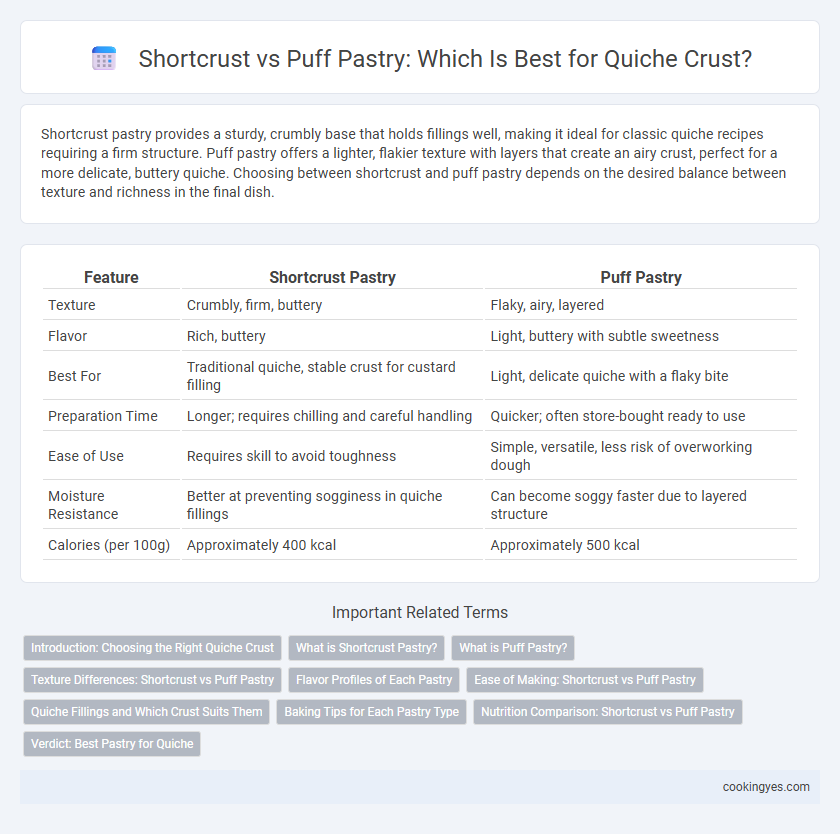Shortcrust pastry provides a sturdy, crumbly base that holds fillings well, making it ideal for classic quiche recipes requiring a firm structure. Puff pastry offers a lighter, flakier texture with layers that create an airy crust, perfect for a more delicate, buttery quiche. Choosing between shortcrust and puff pastry depends on the desired balance between texture and richness in the final dish.
Table of Comparison
| Feature | Shortcrust Pastry | Puff Pastry |
|---|---|---|
| Texture | Crumbly, firm, buttery | Flaky, airy, layered |
| Flavor | Rich, buttery | Light, buttery with subtle sweetness |
| Best For | Traditional quiche, stable crust for custard filling | Light, delicate quiche with a flaky bite |
| Preparation Time | Longer; requires chilling and careful handling | Quicker; often store-bought ready to use |
| Ease of Use | Requires skill to avoid toughness | Simple, versatile, less risk of overworking dough |
| Moisture Resistance | Better at preventing sogginess in quiche fillings | Can become soggy faster due to layered structure |
| Calories (per 100g) | Approximately 400 kcal | Approximately 500 kcal |
Introduction: Choosing the Right Quiche Crust
Shortcrust pastry offers a firm, crumbly texture that supports rich quiche fillings without becoming soggy, making it ideal for traditional quiche Lorraine or vegetable quiches. Puff pastry creates a light, flaky crust with multiple layers that add a delicate crunch and visually appealing rise, perfect for more elegant or contemporary quiche recipes. Selecting between shortcrust and puff pastry depends on the desired texture and presentation, with shortcrust emphasizing sturdiness and puff pastry enhancing crispness.
What is Shortcrust Pastry?
Shortcrust pastry is a type of dough made primarily from flour, fat (usually butter), and water, renowned for its crumbly, tender texture that provides a sturdy base for quiche fillings. Unlike puff pastry, which is flaky and layered due to repeated folding and rolling, shortcrust offers a simpler, more compact crust that holds moist ingredients without becoming soggy. Its dense consistency creates a balanced contrast with creamy quiche centers, making it a popular choice for both sweet and savory quiches.
What is Puff Pastry?
Puff pastry is a light, flaky dough made by layering butter between sheets of dough and repeatedly folding and rolling it to create multiple thin layers that puff up during baking. This laminated dough rises significantly, producing a delicate, crisp crust perfect for quiches that require a tender yet sturdy base. Unlike shortcrust pastry, puff pastry offers a more airy texture and a buttery flavor that enhances the overall richness of savory quiche fillings.
Texture Differences: Shortcrust vs Puff Pastry
Shortcrust pastry offers a dense, crumbly texture that provides a sturdy base for quiche, enhancing the filling's richness without overpowering it. Puff pastry features multiple flaky, buttery layers that create a light, airy crust with a delicate crunch, adding a contrasting texture to the soft quiche interior. Choosing between shortcrust and puff pastry affects the mouthfeel significantly, with shortcrust delivering a firm bite and puff pastry offering a flaky, tender structure.
Flavor Profiles of Each Pastry
Shortcrust pastry offers a buttery, crumbly texture with a rich, slightly sweet flavor that complements savory fillings in quiche. Puff pastry provides a light, flaky, and airy crust with a subtle buttery taste, creating a delicate contrast to dense quiche ingredients. The choice between shortcrust and puff pastry impacts the overall flavor balance and mouthfeel of the quiche, influencing its culinary appeal.
Ease of Making: Shortcrust vs Puff Pastry
Shortcrust pastry is easier to make for quiche crust due to its simple ingredients and straightforward preparation, requiring less chilling and fewer steps. Puff pastry involves multiple folds and layers, making it more time-consuming and technique-sensitive. For home cooks seeking convenience, shortcrust offers a reliable and faster option without compromising texture.
Quiche Fillings and Which Crust Suits Them
Shortcrust pastry offers a sturdy, crumbly base that supports dense and creamy quiche fillings like spinach and cheese or bacon and leek, preventing sogginess and maintaining structure during baking. Puff pastry, with its light and flaky texture, complements lighter, custard-based quiches such as tomato and herb or mushroom and thyme, adding a delicate crunch that contrasts with soft fillings. Choosing the right crust depends on filling moisture and texture, where shortcrust enhances heavy, rich ingredients and puff pastry elevates airy, vegetable-centric combinations.
Baking Tips for Each Pastry Type
Shortcrust pastry requires careful blind baking with pie weights to prevent shrinkage and maintain a crisp base for quiche fillings, while puff pastry benefits from docking and partial blind baking to promote even puffing and prevent sogginess. Use chilled ingredients and minimal handling for shortcrust to avoid toughness, whereas for puff pastry, keep dough cold to preserve the layers and achieve a flaky texture. Adjust baking times with a lower temperature for puff pastry to ensure thorough cooking without burning the delicate layers.
Nutrition Comparison: Shortcrust vs Puff Pastry
Shortcrust pastry typically contains fewer calories and less fat compared to puff pastry, making it a lighter option for quiche crust. Puff pastry, known for its multiple layers of butter, has higher saturated fat content and increased caloric density, which can impact overall nutritional intake. Choosing shortcrust pastry may support a more balanced diet while still providing a sturdy and flavorful base for quiche.
Verdict: Best Pastry for Quiche
Shortcrust pastry is the best pastry for quiche due to its sturdy texture that holds fillings without becoming soggy, providing a crisp and buttery base that complements savory ingredients. Puff pastry offers a light, flaky texture but tends to rise and separate from the filling, making it less ideal for maintaining quiche structure. For a classic quiche with balanced flavor and optimal texture, shortcrust pastry remains the preferred choice among chefs and bakers.
Shortcrust vs Puff Pastry for quiche crust Infographic

 cookingyes.com
cookingyes.com